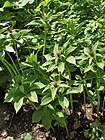Note: This is a project under development. The articles on this wiki are just being initiated and broadly incomplete. You can Help creating new pages.
Difference between revisions of "Paris polyphylla"
(→Identification) |
|||
| Line 37: | Line 37: | ||
===Flower=== | ===Flower=== | ||
| − | {{Flower|Bisexual|Narrowly ovate-lanceolate to lanceolate| | + | {{Flower|Bisexual|Narrowly ovate-lanceolate to lanceolate|Yellow-green||3–5 mm in length, while the inner tepals are usually yellow-green, narrowly linear, and are shorter or longer than outer ones (about 1.5 mm long)}} |
===Other features=== | ===Other features=== | ||
Latest revision as of 17:47, 26 June 2020
Paris polyphylla is an Asian species of flowering plant. It is native to China, Taiwan, the Indian Subcontinent and Indochina. It produces spider-like flowers that throw out long, thread-like, yellowish green petals throughout most of the warm summer months and into the autumn. In the fall, the flowers are followed by small, scarlet berries.
Contents
- 1 Uses
- 2 Parts Used
- 3 Chemical Composition
- 4 Common names
- 5 Properties
- 6 Habit
- 7 Identification
- 8 List of Ayurvedic medicine in which the herb is used
- 9 Where to get the saplings
- 10 Mode of Propagation
- 11 How to plant/cultivate
- 12 Commonly seen growing in areas
- 13 Photo Gallery
- 14 References
- 15 External Links
Uses
Analgesic, Antibacterial, Anti- phlogistic, Antispasmodic, Antitussive, Any poisonous bites, Burn, Cut or injury, Depurative, Detoxification, Diarrhea, Dressing.
Parts Used
Chemical Composition
The compounds were identified as: β-sitosterol; ergosta-7, 22-dien-3-one; β-ecdysone; kaempferol; daucosterol; luteolin; calonysterone; luteolin-7-O-glucoside; quercetin; and 3β, 5α, 9α- trihydroxyergosta-7, 22dien-6-one.[1]
Common names
| Language | Common name |
|---|---|
| Kannada | |
| Hindi | |
| Malayalam | |
| Tamil | |
| Telugu | |
| Marathi | NA |
| Gujarathi | NA |
| Punjabi | NA |
| Kashmiri | NA |
| Sanskrit | |
| English | Himalayan Paris |
Properties
Reference: Dravya - Substance, Rasa - Taste, Guna - Qualities, Veerya - Potency, Vipaka - Post-digesion effect, Karma - Pharmacological activity, Prabhava - Therepeutics.
Dravya
Rasa
Guna
Veerya
Vipaka
Karma
Prabhava
Habit
Identification
Leaf
| Kind | Shape | Feature |
|---|---|---|
| Simple | Rounded to cuneate in shape | Leaves are found in a whorl of 4 to 9 leaves and they are petioled (4–6 cm), Leaves are 2.5–5.0 cm wide. The dull-green leaves contain three primary veins and spread out in a horizontal whorl at the top of the stem |
Flower
| Type | Size | Color and composition | Stamen | More information |
|---|---|---|---|---|
| Bisexual | Narrowly ovate-lanceolate to lanceolate | Yellow-green | 3–5 mm in length, while the inner tepals are usually yellow-green, narrowly linear, and are shorter or longer than outer ones (about 1.5 mm long) |
Other features
List of Ayurvedic medicine in which the herb is used
Where to get the saplings
Mode of Propagation
How to plant/cultivate
Paris polyphylla Sm. (Satuwa) is one of the medicinal plants listed as vulnerable by the IUCN. [3]
Commonly seen growing in areas
Photo Gallery
References
External Links
- Ayurvedic Herbs known to be helpful to treat Analgesic
- Ayurvedic Herbs known to be helpful to treat Antibacterial
- Ayurvedic Herbs known to be helpful to treat Anti- phlogistic
- Ayurvedic Herbs known to be helpful to treat Antispasmodic
- Ayurvedic Herbs known to be helpful to treat Antitussive
- Ayurvedic Herbs known to be helpful to treat Any poisonous bites
- Ayurvedic Herbs known to be helpful to treat Burn
- Ayurvedic Herbs known to be helpful to treat Cut or injury
- Ayurvedic Herbs known to be helpful to treat Depurative
- Ayurvedic Herbs known to be helpful to treat Detoxification
- Ayurvedic Herbs known to be helpful to treat Diarrhea
- Ayurvedic Herbs known to be helpful to treat Dressing
- Herbs with Leaves used in medicine
- Herbs with common name in English
- Habit - Herbs
- Index of Plants which can be propagated by Seeds
- Herbs that are commonly seen in the region of Lowland forest
- Herbs
- Melanthiaceae



